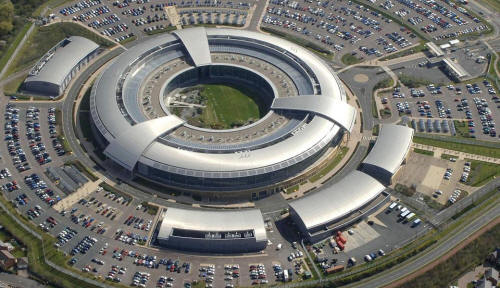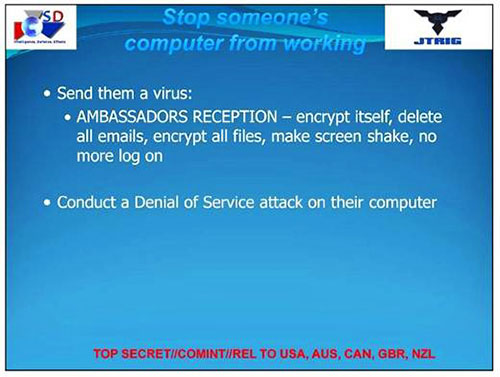
by Matthew Cole, Richard Esposito, Mark Schone and
Glenn Greenwald
February 7, 2014
from
NBCNews Website
Spanish version
|
Matthew Cole is an
investigative producer for NBC News focusing on national
security matters. He joined NBC News in 2013 after three years
as an investigative producer for ABC News. He has reported from
Afghanistan, Pakistan and several countries in the Middle East,
focusing on terrorism, war and intelligence. |

GCHQ - Britain
Communication Headquarters
British spies have developed "dirty tricks" for use against nations,
hackers, terror groups, suspected criminals and arms dealers that include,
-
releasing computer viruses
-
spying on journalists and diplomats
-
jamming phones and computers
-
using sex to lure targets into "honey
traps"
Documents taken from the National Security
Agency by
Edward Snowden and exclusively obtained
by NBC News describe techniques developed by a secret British spy unit
called the Joint Threat Research and Intelligence Group (JTRIG)
as part of a growing mission to go on offense and attack adversaries ranging
from Iran to the hacktivists of Anonymous.
According to the documents, which come from
presentations prepped in 2010 and 2012 for NSA cyber spy conferences, the
agency's goal was to,
"destroy, deny, degrade [and] disrupt"
enemies by "discrediting" them, planting misinformation and shutting
down their communications.
Both PowerPoint presentations describe "Effects"
campaigns that are broadly divided into two categories: cyber attacks and
propaganda operations.
The propaganda campaigns use deception, mass
messaging and "pushing stories" via,
-
Twitter
-
Flickr
-
Facebook
-
YouTube
JTRIG also uses "false flag" operations, in
which British agents carry out online actions that are designed to look like
they were performed by one of Britain's adversaries.
In connection with this report, NBC is publishing documents that Edward
Snowden took from the NSA before fleeing the U.S., which can be
here and
here.
The documents are being published with minimal redactions.
The spy unit's cyber attack methods include the same "denial of service" or
DDOS tactic used by computer hackers to shut down government and corporate
websites.
Other documents taken from the NSA by Snowden and previously published by
NBC News show that JTRIG, which is part of the NSA's British counterpart,
the cyber spy agency known as GCHQ, used a DDOS attack to shut down Internet
chat rooms used by members of the hacktivist group known as Anonymous.
Civil libertarians said that in using a DDOS
attack against hackers the British government also infringed free speech by
individuals not involved in any illegal hacking, and may have blocked other
websites with no connection to Anonymous.
While GCHQ defends the legality of its actions,
critics question whether the agency is too aggressive and its mission too
broad.
Eric King, a lawyer who teaches IT law at the London School of
Economics and is head of research at
Privacy International, a British civil
liberties advocacy group, said it was "remarkable" that the British
government thought it had the right to hack computers, since none of the
U.K.'s intelligence agencies has a "clear lawful authority" to launch their
own attacks.
"GCHQ has no clear authority to send a virus
or conduct cyber attacks," said King. "Hacking is one of the most
invasive methods of surveillance."
King said British cyber spies had gone on
offense with "no legal safeguards" and without any public debate, even
though the British government has criticized other nations, like Russia, for
allegedly engaging in cyber warfare.
But intelligence officials defended the British government's actions as
appropriate responses to illegal acts.
One intelligence official also said that the
newest set of Snowden documents published by NBC News that describe
"Effects" campaigns show that British cyber spies were "slightly ahead" of
U.S. spies in going on offense against adversaries, whether those
adversaries are hackers or nation states.
The documents also show that a one-time signals
surveillance agency, GCHQ, is now conducting the kinds of active espionage
operations that were once exclusively the realm of the better-known British
spy agencies MI5 and MI6.
Intelligence officials defended the British government's actions as
appropriate responses to illegal acts.
According to notes on the 2012 documents, a computer virus called
Ambassadors Reception was,
"used in a variety of different areas" and
was "very effective."
When sent to adversaries, says the presentation,
the virus will,
"encrypt itself, delete all emails, encrypt
all files, make [the] screen shake" and block the computer user from
logging on.
But the British cyber spies' operations do not
always remain entirely online.
Spies have long used sexual "honey traps" to
snare, blackmail and influence targets. Most often, a male target is led to
believe he has an opportunity for a romantic relationship or a sexual
liaison with a woman, only to find that the woman is actually an
intelligence operative.
The Israeli government, for example, used a
"honey trap" to lure nuclear technician Mordechai Vanunu from London
to Rome. He expected an assignation with a woman, but instead was kidnapped
by Israel agents and taken back to Israel to stand trial for leaking nuclear
secrets to the media.
The version of a "honey trap" described by British cyber spies in the 2012
PowerPoint presentation sounds like a version of Internet dating, but
includes physical encounters.
The version of a "honey trap" described by British cyber spies in the 2012
PowerPoint presentation sounds like a version of Internet dating, but
includes physical encounters.
The target is lured,
"to go somewhere on the Internet, or a
physical location" to be met by "a friendly face."
The goal, according to the presentation, is to
discredit the target.
A "honey trap," says the presentation, is
"very successful when it works."
But the documents do not give a specific example
of when the British government might have employed a honey trap.
An operation described in the 2010 presentation also involves in-person
surveillance.
"Royal Concierge" exploits hotel
reservations to track the whereabouts of foreign diplomats and send out
"daily alerts to analysts working on governmental hard targets."
The British government uses the program to try
to steer its quarry to "SIGINT friendly" hotels, according to the
presentation, where the targets can be monitored electronically - or in
person by British operatives.

A slide from the
documents taken from the NSA by Edward Snowden
and obtained by NBC News.
The existence of the Royal Concierge program was first reported by the
German magazine Der Spiegel in 2013, which said that Snowden documents
showed that British spies had monitored bookings of at least 350 upscale
hotels around the world for more than three years,
"to target, search and analyze reservations
to detect diplomats and government officials."
According to the documents obtained by NBC News,
the intelligence agency uses the information to spy on human targets through
"close access technical operations," which can include listening in on
telephone calls and tapping hotel computers as well as sending intelligence
officers to observe the targets in person at the hotels.
The documents ask,
"Can we influence hotel choice? Can we
cancel their visits?"
The 2010 presentation also describes another
potential operation that would utilize a technique called "credential
harvesting" to select journalists who could be used to spread information.
According to intelligence sources, spies
considered using electronic snooping to identify non-British journalists who
would then be manipulated to feed information to the target of a covert
campaign. Apparently, the journalist's job would provide access to the
targeted individual, perhaps for an interview.
The documents do not specify whether the
journalists would be aware or unaware that they were being used to funnel
information.
The executive director of the Committee to Protect Journalists, Joel
Simon, said that the revelation about "credential harvesting" should
serve as a "wake up call" to journalists that intelligence agencies can
monitor their communications.
Simon also said that governments put all
journalists at risk when they use even one for an intelligence operation.
"All journalists generally are then
vulnerable to the charge that they work at the behest of an intelligence
agency," said Simon.
The journalist operation was never put into
action, according to sources, but other techniques described in the
documents, like the Ambassadors Reception computer virus and the jamming of
phones and computers, have definitely been used to attack adversaries.
In Afghanistan, according to the 2012 presentation, the British used a
blizzard of text messages, phone calls and faxes to "significantly disrupt"
Taliban communications, with texts and calls programmed to arrive every
minute.
In a set of operations that intelligence sources say were designed to stop
weapons transactions and nuclear proliferation, JTRIG used negative
information to attack private companies, sour business relationships and
ruin deals.
The British cyber spies also used blog posts and information spread via
blogs in an operation against Iran.
Other effective methods of cyber attack listed in the documents include
changing photos on social media sites and emailing and texting colleagues
and neighbors unsavory information.
The documents do not give examples of when these
techniques were used, but intelligence sources say that some of the methods
described have been used by British intelligence to help British police
agencies catch suspected criminals.
The documents from 2010 note that "Effects" operations, GCHQ's offensive
push against Britain's enemies, had become a "major part" of the spy
agency's business.
The presentation from 2012 illustrates that two years later GCHQ had
continued to shift its workload from defending U.K. cyber networks to going
on offense - targeting specific people or governments.
The British government's intelligence apparatus,
which also includes MI5 and MI6, had a role in the 2010
Stuxnet computer virus attack on Iran's
nuclear facilities, according to sources at two intelligence agencies.
GCHQ would not comment on the newly published documents or on JTRIG's
"Effects" operations. It would neither confirm nor deny any element of this
report, which is the agency's standard policy.
In a statement, a GCHQ spokesperson emphasized
that the agency operated within the law.
"All of GCHQ's work is carried out in
accordance with a strict legal and policy framework," said the
statement, "which ensure[s] that our activities are authorized,
necessary and proportionate, and that there is rigorous oversight,
including from the Secretary of State, the Interception and Intelligence
Services Commissioners and the Parliamentary Intelligence and Security
Committee.
All of our operational processes rigorously
support this position."
Journalist Glenn Greenwald was formerly a
columnist at Salon and the Guardian.
In late 2012 he was contacted by NSA contractor
Edward Snowden, who later provided him with thousands of sensitive
documents, and he was the first to report on Snowden's documents in June
2013 while on the staff of the Guardian.
Greenwald has since reported on the documents
with multiple media outlets around the world, and has won several journalism
awards for his NSA reporting both in the U.S. and abroad.
He is now helping launch, and will write for, a
new, non-profit media outlet known as
First Look Media that will,
"encourage, support and empower…
independent, adversarial journalists."


